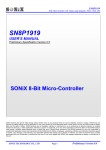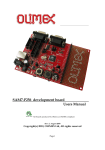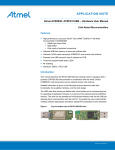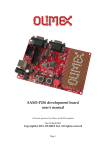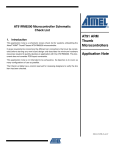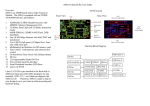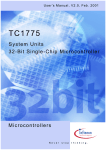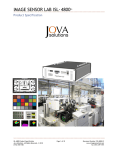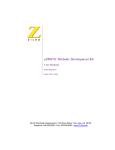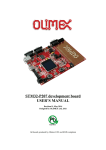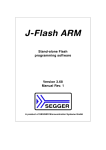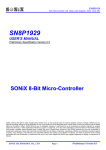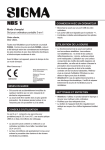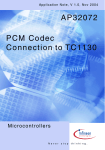Download DIMM-RM9200
Transcript
DIMM-RM9200 Hardware Manual Document Revision V1.06 DIMM-RM9200 1 Contents 1 2 3 4 Contents Pictures Tables User Information 4.1 About This Manual 4.2 Copyright 4.3 Trademarks 4.4 Limited Warranty for Open Source Software 4.5 Technical Support 5 Introduction 5.1 DIMM- RM9200 Architecture 5.2 Feature Summary 5.3 Block Diagram 5.4 Component View 5.5 Functional Description 5.5.1 SO-DIMM connector 5.5.2 Power supply 5.5.3 Memory Layout 5.5.4 Ethernet Phy 6 DIMM-RM9200 Module Pinout 7 DIMM-RM9200 Peripherals Pinout 7.1 USART0 7.2 USART1 7.3 USART2 7.4 USART3 7.5 SPI 7.6 MCI 7.7 TWI 7.8 SSC0 7.9 SSC1 8 Signal Description 8.1 Address / Data Bus 8.2 Control Signals 8.2.1 nRESET 8.2.2 nOE 8.2.3 nWE 8.2.4 NBS1/nBS3 8.2.5 nRESET_IN 8.2.6 nBOOTMODE 8.3 Peripherals 8.3.1 Ethernet 9 Mechanical Dimensions 9.1 DIMM-RM9200 Module 9.2 DIMM Connector 10 Installing the DIMM-RM9200 10.1 Installing the module 11 Technical Specifications DIMM-RM9200 Module Specification 2 4 5 6 6 6 6 6 7 8 8 9 9 10 10 10 11 11 12 13 15 15 15 15 16 16 16 17 17 17 18 18 18 18 18 18 18 19 19 19 19 20 20 20 21 21 22 2 DIMM-RM9200 12 Important Documents 12.1 Atmel AT91RM9200 Datasheet 12.2 Atmel AT91RM9200 Errata Sheet 12.3 Micrel KS8721BL/SL Datasheet 12.4 Micrel KS8001L/S Datasheet 12.5 Intel Embedded Flash Memory (J3 v. D) Datasheet 12.6 Intel StrataFlash Embedded Memory (P30) Family Datasheet 13 Hardware Revision History 14 Document Revision History DIMM-RM9200 Module Specification 24 24 24 24 24 24 24 25 26 3 DIMM-RM9200 2 Pictures Module Block Diagram Placeplan Module Dimensions DIMM-RM9200 Module Specification 9 10 20 4 DIMM-RM9200 3 Tables Module Pinout USART0 Port Pinout USART1 Port Pinout USART2 Port Pinout USART3 Port Pinout SPI Port Pinout MCI Port Pinout TWI Port Pinout SSC0 Port Pinout SSC1 Port Pinout DIMM Socket Selection DIMM-RM9200 Module Specification 14 15 15 15 16 16 16 17 17 17 20 5 DIMM-RM9200 4 User Information 4.1 About This Manual This document provides information about products from NEMONOS GmbH. No warranty of suitability, purpose, or fitness is implied. While every attempt has been made to ensure that the information in this document is accurate, the information contained within is supplied “as-is” and is subject to change without notice. For the circuits, descriptions and tables indicated, NEMONOS assumes no responsibility as far as patents or other rights of third parties are concerned as well as for any errors or inaccuracies that may appear in this document. NEMONOS reserves the right to make changes, without notice, in the products, including circuits and/or software described or contained in this manual, in order to improve design and/or performance. NEMONOS assumes no responsibility or liability for the use of the described product(s). Applications that are described in this manual are for illustrative purpose only. NEMONOS makes no representation or warranty that such application will be suitable for the specified use without further testing or modification. 4.2 Copyright Copyright © 2005 by NEMONOS GmbH. All rights reserved. No part of this manual may be reproduced, transmitted, transcribed, stored in a retrieval system, or translated into any language or computer language, in any form or by any means (electronic, mechanical, photocopying, recording, or otherwise), without the express written permission of NEMONOS GmbH. 4.3 Trademarks All products and trademarks mentioned in this manual are trademarks of their respective owners. 4.4 Limited Warranty for Open Source Software On customer demand, our modules can be shipped with open source software. As the linux kernel as well as the u-boot bootloader are distributed under GPL, version 2, the terms and conditions of this GPL , version 2 also apply to the u-boot and kernel we distribute. You got the sources for the linux kernel and u-boot together with the DIMM-RM9200 evaluation board. In case you didn’t get the CD, please contact us and we will provide you with a download link for the sources and patches. Please read the GPL version 2, which is included in file ‘COPYING’ in the u-boot as well as the kernel main folder carefully. Especially the following warranty applies to the sources / binaries of u-boot and linux kernel we redistribute: BECAUSE THE PROGRAM IS LICENSED FREE OF CHARGE, THERE IS NO WARRANTY FOR THE PROGRAM, TO THE EXTENT PERMITTED BY APPLICABLE LAW. EXCEPT WHEN OTHERWISE STATED IN WRITING THE COPYRIGHT HOLDERS AND/OR OTHER PARTIES PROVIDE THE PROGRAM "AS IS" WITHOUT WARRANTY OF ANY KIND, EITHER EXPRESSED OR IMPLIED, INCLUDING, BUT NOT LIMITED TO, THE IMPLIED WARRANTIES OF MERCHANTABILITY AND FITNESS FOR A PARTICULAR PURPOSE. THE ENTIRE RISK AS TO THE QUALITY AND PERFORMANCE OF THE PROGRAM IS WITH YOU. SHOULD THE DIMM-RM9200 Module Specification 6 DIMM-RM9200 PROGRAM PROVE DEFECTIVE, YOU ASSUME THE COST OF ALL NECESSARY SERVICING, REPAIR OR CORRECTION. IN NO EVENT UNLESS REQUIRED BY APPLICABLE LAW OR AGREED TO IN WRITING WILL ANY COPYRIGHT HOLDER, OR ANY OTHER PARTY WHO MAY MODIFY AND/OR REDISTRIBUTE THE PROGRAM AS PERMITTED ABOVE, BE LIABLE TO YOU FOR DAMAGES, INCLUDING ANY GENERAL, SPECIAL, INCIDENTAL OR CONSEQUENTIAL DAMAGES ARISING OUT OF THE USE OR INABILITY TO USE THE PROGRAM (INCLUDING BUT NOT LIMITED TO LOSS OF DATA OR DATA BEING RENDERED INACCURATE OR LOSSES SUSTAINED BY YOU OR THIRD PARTIES OR A FAILURE OF THE PROGRAM TO OPERATE WITH ANY OTHER PROGRAMS), EVEN IF SUCH HOLDER OR OTHER PARTY HAS BEEN ADVISED OF THE POSSIBILITY OF SUCH DAMAGES. 4.5 Technical Support Technicians and engineers from NEMONOS are available for technical support. We are committed to making our product easy to use and will help you use our products in your systems. Before contacting NEMONOS technical support, please consult our web site for the latest product documentation, utilities, and drivers. If the information does not help to solve the problem, contact us by email or telephone. © 2005 NEMONOS GmbH Embedded System Design Bernstorffstrasse 99 D-22767 Hamburg Telefon: +49 40 401716-00 Telefax: +49 40 401716-07 Internet: www.nemonos.com E-Mail: [email protected] DIMM-RM9200 Module Specification 7 DIMM-RM9200 5 Introduction 5.1 DIMM- RM9200 Architecture The application-specific portion of a standard embedded application typically requires low pin count components such as relays, power supplies and A/D-converters. An embedded Controller requires components of much higher pin-count and higher density circuit boards. The DIMM- RM9200 concept separates the high-density circuit board of the embedded Controller from the low density, often two-layer, application-specific baseboard. To address the drawback of a higher price for an embedded controller-like solution, the DIMM-RM9200 performs without discrete peripheral connectors, significantly reducing the cost. In other embedded controller solutions, connectors and their assembly are a significant part of the manufacturing costs. In "low end" solutions, these costs can be as much as 25%. Because the DIMM-RM9200 performs without connectors, these costs are significantly decreased and the controller can be integrated on a smaller board surface. The reduction in the number of steps necessary in manufacturing and assembling the component group is another cost-decreasing factor. The one-sided reflow process, as well as exclusion of the wavesolder process, serves to increase the yield in manufacturing and improve quality. The required SO-DIMM connector is a very inexpensive, standard component and is available from numerous manufacturers. In designing the DIMM-RM9200, attention was directed toward its use in embedded applications. Because most peripheral interfaces used in such applications are device-internal (in external interfaces, mainly special customized interfaces are used), the serial interface driver components have been excluded from the DIMM-RM9200, leading the interfaces as pure TTL signals to the outside. This further decreases additional costs, while enabling the user to have more flexibility when selecting the interface driver (RS485, RS422, RS232, TTY etc.). The power consumption of the controller architecture is drastically reduced due to the integrated components. This makes the system optimally adaptable with power-saving modes. The DIMM-RM9200 also has minimized or eliminated some of the most critical disadvantages of the microcontroller: • The DIMM-RM9200 today needs less board surface than most micro-controller applications. • The embedded controller cost has been drastically decreased by the DIMM-RM9200. • The DIMM-RM9200 architecture has eliminated the complicated cabling of an embedded PC. The user receives important advantages by using a DIMM-RM9200. Because of the availability of numerous development platforms, the user can begin the software development immediately on any platform with the AT91RM9200. This is a factor that may influence the success of a product in today’s market, where "time to market" is of high importance. As target hardware becomes available, it can be implemented with no obstacles to operation because it will be unnecessary to change the software. With the SO-DIMMconnector, an exchange for other CPU types is possible, increasing the scalability of the ultimate device. In the case of product information and new designs, the CPU may simply be superseded by a new DIMMmodule, saving redesign time. Through continuous development of the DIMM modules, the cost for the life span of a product can be reduced, profiting users. DIMM-RM9200 Module Specification 8 DIMM-RM9200 5.2 Feature Summary • • • • • • • • • • • • • • • • • ATMEL AT91RM9200 microcontroller in BGA package with 190 MHz ARM9 CPU UBOOT GPL boot loader LINUX operating system / optional WinCE supported 32 MB SDRAM memory (optional 64 MB) 32-bit SDRAM data bus 16 MB Flash memory (optional 32 MB) 16-bit Flash data bus buffered external 23 bit address / 16 bit data bus 10 / 100Mbit Ethernet with on board physical layer and fast MII interface 4 serial interfaces 2 USB host ports 1 USB function port optional 2 Mb serial flash for configuration or customer data 12 optional LEDs (1 power, 8 user, 3 ethernet) for status display on board 1.8V power supply for processor core voltage 144-pins SO-DIMM card edge connector ultra small size (67.6 mm x 36.5 mm) 5.3 Block Diagram DATA FLASH SPI Memory IF SDRAM USART USB Device BUFFER 16 Bit Data / 23 Bit Address SSI/ I2S GPIO/ CF Ethernet 10/100MBit MMC/SD AT91RM9200 ARM920T CPU with MMU FLASH USB Host MII 10/100MBit Ethernet Phy 3.3V 1.8V Regulator SO-DIMM connector AT91RM9200 DIMM Picture 1: Module Block Diagram DIMM-RM9200 Module Specification 9 DIMM-RM9200 5.4 Component View Picture 2: Placeplan 5.5 Functional Description 5.5.1 SO-DIMM connector All external connections are accessible through the 144-pins SO-DIMM card edge connector. The following external functionality is available: • 3V3 power supply input • 1V8 power supply output (max. 50mW) • buffered address bus with address lines A0 through A22 • buffered data bus with data lines D0 through D15 • buffered read/write strobes and byte select signals • unbuffered chip selects nCS2 through nCS7 • reset_out, reset_in and interrupts • serial interfaces • timer inputs and outputs • 1 USB host and 2 USB device interfaces • JTAG interface and dbg_USART, used during production • 10/100Mbit Ethernet signals The internal circuitry of the DIMM-RM9200 is based on 3V3 low voltage technology, but the address and data bus SO-DIMM signals are 5 V tolerant. Therefore you can use both 3V3 and 5 V components to interface to the SO-DIMM connector. All other interface signals are 3V3 only. DIMM-RM9200 Module Specification 10 DIMM-RM9200 5.5.2 Power supply 5.5.2.1 External power supply The DIMM-RM9200 requires an external power supply. You have to power the DIMM-RM9200 with a 3V3 / 0,5 A external power supply, connected to the 3V3 pins on the SO-DIMM connector. When using an external power supply, it is strongly advised to place a low ESR capacitor on the carrier board close to the 3V3 input to reduce interference. 5.5.2.2 On board power supply The core supply voltage for the AT91RM9200 is generated on board and is available for reference on the 1V8 pin of the SO-DIMM connector. The power consumption of external components, if any, must be limited to 50mW. 5.5.3 Memory Layout Equipped with either 64Mbit, 128 Mbit or 256 Mbit Intel Strata Flash as well as with two SDRAMs of each 128 Mbit or 256 Mbit the DIMM-RM9200 realizes a total of 8, 16 or 32 Mbyte Flash and 32 or 64 Mbyte SDRAM. Standard variants are 8MByte / 32 MByte Flash / SDRAM respectively 32 / 64 MByte Flash / SDRAM. Using A25 for the chip-internally not bonded A24 address line it is possible to address 32 MByte of Flash-Memory (for the missing A24 problem please take a look in the errata for the ATMEL AT91RM9200). 5.5.3.1 Flash (chip select NCS0) The flash memory is accessed 16 bits wide with NCS0. The resulting address range for the two standard options are: 16 MByte: 0x1000 0000 - 0x10FF FFFF (JL28F128J3A) 32 MByte: 0x1000 0000 - 0x10FF FFFF 1.segment (16 Mbyte) (JL28F256J3C/PF48F4000P0Z) 0x1100 0000 - 0x11FF FFFF mirror of 1. segment (16 Mbyte) 0x1200 0000 - 0x12FF FFFF 2. segment (16 Mbyte) The gap in the flash memory area for the 32MByte device can be avoided by addressing the flash starting at offset 0x1100 0000. This results in the following memory layout: 32 MByte: 0x1100 0000 - 0x11FF FFFF 1.segment (16 Mbyte) (JL28F256J3C/PF48F4000P0Z) 0x1200 0000 - 0x12FF FFFF 2. segment (16 Mbyte) 5.5.3.2 SDRAM (chip select NCS1) The SDRAM is accessed with 32 bit data bus width at NCS1. This results in the following address range for the standard memory options: 32 MByte: 0x2000 0000 - 0x21FF FFFF (MT48LC8M16A2) 64 MByte: 0x2000 0000 - 0x23FF FFFF (MT48LC16M16A2) 5.5.3.3 Serial data flash (chip select NPCS0) An optional serial data flash of type AT25DB021B will be accessed using the SPI chip select NPCS0. The data flash can be used for storage of configuration data or a bootloader. Booting U-Boot with TFTP feature from the data flash in a network environment, the Strata Flash can be omitted further reducing the system costs. DIMM-RM9200 Module Specification 11 DIMM-RM9200 5.5.3.4 Address / data bus buffer All chip selects but NCS1 (SDRAM) activate the on-board data-bus buffers. Activity on the external data bus interface thus is reduced to a minimum. The address bus buffers are always activated, allowing for further external logic with fast timing. The buffers are 5V tolerant 3.3V devices (74LCX16245) allowing the connection of either 3.3V or 5V external devices. In addition to the address lines A0..A22 and data lines D0..D15, the signals common to multiple external devices (NOE, NWE, BS1 and BS3) are buffered. The chip select signals NCS2..NCS7 are not buffered. 5.5.3.5 Special notes for watchdog usage As the DIMM-RM9200 uses Intel StrataFlash for Program storage and as boot device, special care has to be taken, when using the Flash as filesystem storage device (e.g. as JFFS2-Image Source under Linux). The Intel Flashes can be switched into ‘Read Status’ mode in order to get the status of the chip, e.g. after writing a sector. This command can be disabled by software command ‘Read Array’ command, or by hardware reset. A problem can arise, if a watchdog reset occurs, while the flash is in ‘Read Status’ mode. The processor resets and tries to fetch the first instruction from flash. As the flash remains in ‘Read Status’ command (the watchdog reset is only internal to the AT91RM9200 chip), the program fetch will fail and the system will stall. In order to circumvent this behavior there is a patch available for the linux kernel, which uses the watchdog interrupt to reset the flash into ‘Read Array’ mode before asserting a watchdog reset. However, this is not 100% secure. If you need 100% security, you have to use an external watchdog circuitry. 5.5.4 Ethernet Phy A Micrel KS8721 or Micrel KS8001 is used as physical layer chip. This low-power transceiver for 10/100BASE-TX performs auto negotiation compliant with IEEE 802.3u and auto crossover function. It is specified for the industrial temperature range. The whole Ethernet interface is formed with the fast Media Independent Interface (MII) and the Media Access Control Layer (MAC) of the Atmel AT91RM9200 combined with the Micrel PHY supplemented through an external RJ45-Modular Jack with integrated inductance. A symmetrical kind of Modular Jack is needed for auto MDIX functionality. A good choice for a transformer is ‘PH163539’ from YCL. ‘J0024D21’ from Pulse can be used as ethernet connector with integrated transformer. DIMM-RM9200 Module Specification 12 DIMM-RM9200 6 DIMM-RM9200 Module Pinout Pin 1 3 5 7 9 11 13 15 17 19 21 23 25 27 29 31 33 35 37 39 41 43 45 47 49 51 53 55 57 59 61 63 65 67 69 71 73 75 77 79 81 83 85 Interface Power Data Data Data Data Data Data Data Data Address Address Address Address Address Address Address Address Address Address Address Address Control Control Control Control;I/O Control;I/O Control;I/O Control;I/O Control;I/O Control Power Power SPI;I/O SPI SPI SPI JTAG USART1 USART0 SPI;I/O Timer;I/O Timer;I/O Timer;I/O Signal GND D15 D14 D13 D12 D11 D10 D9 D8 A21 A20 A19 A18 A17 A16 A15 A14 A13 A12 A11 A10 NOE NWE nCS2 PC10/nCS4/CFCS PC12/nCS6/CFCE2 PC6/NWAIT PB28/FIQ PA26/TWCK/IRQ1 NBOOTMODE GND 3V3 PA3/nPCS0/IRQ5 PA1/MOSI/PCK0 PA2/SPCK/IRQ4 PA0/MISO/PCK3 TCK PB24/nUSART1_CTS PD21/nUSART0_RTS PD18/nPCS1 PB13/TK2 PB27/PCK0 PB2/TD0/SCK3 DIMM-RM9200 Module Specification Dir I/O I/O I/O I/O I/O I/O I/O I/O OUT OUT OUT OUT OUT OUT OUT OUT OUT OUT OUT OUT OUT OUT OUT I/O I/O I/O I/O I/O I/O I/O I/O I/O I/O IN I/O I/O I/O I/O I/O I/O Pin 2 4 6 8 10 12 14 16 18 20 22 24 26 28 30 32 34 36 38 40 42 44 46 48 50 52 54 56 58 60 62 64 66 68 70 72 74 76 78 80 82 84 86 Interface Power Power Data Data Data Data Data Data Data Data Address Address Address Address Address Address Address Address Address Address Control Control Control Control;I/O Control;I/O Control;I/O Control;I/O Control;I/O Control Power Power Power Power USART1 JTAG USART1 JTAG JTAG USART1 JTAG USART1 SPI;I/O USART1 Signal Dir GND 3V3 D7 I/O D6 I/O D5 I/O D4 I/O D3 I/O D2 I/O D1 I/O D0 I/O A9 OUT A8 OUT A7 OUT A6 OUT A5 OUT A4 OUT A3 OUT A2 OUT A1 OUT A0 OUT NRESET OUT nBS1 OUT nBS3 OUT nCS3/SMCS I/O PC11/nCS5/CFCE1 I/O PC13/nCS7 I/O PB29/IRQ0 I/O PA25/TWD/IRQ2 I/O nRESET_IN IN GND GND 3V3 3V3 PB20/USART1_TXD I/O TDI IN PB21/USART1_RXD I/O TDO OUT TMS IN PB22/USART1_SCLK I/O NTRST IN PB25/nUSART1_DSR I/O PD19/nPCS2 I/O PB23/nUSART1_DCD I/O 13 DIMM-RM9200 Pin 87 89 91 93 95 97 99 101 103 105 107 109 111 113 115 117 119 121 123 125 127 129 131 Interface Timer;I/O USB USB USB USB USB USB Timer;I/O Timer;I/O Timer;I/O MMC;I/O MMC;I/O MMC;I/O I/O I/O I/O Timer;I/O MMC;I/O USART3 Timer;I/O MMC;I/O Power USART0; Timer;I/O 133 USART2 135 137 139 141 143 Signal Dir PB14/TD2 I/O HDPB I/O HDMB I/O HDPA I/O HDMA I/O DDP I/O DDM I/O PB12/TF2 I/O PB6/TF1/TIOA3 I/O PB8/TD1/TIOA4 I/O PB5/RF0/MCDA3 I/O PA29/MCDA0 I/O PA28/MCCDA I/O PC5/BFWE I/O PC1/BFRDY/SMOE I/O PC3/BFBAA/SMWE I/O PA4/PCK1/IRQ5 I/O PA9/MCDB0 I/O PA5/USART3_TXD I/O PA21/TIOA2 I/O PA8/MCCDB I/O GND PA19/USART0_SCK/ I/O TIOA1 PA23/USART2_IRDA I/O _TXD USART0 PA20/nUSART0_CTS I/O DBG_USART PA31/DBG_TXD I/O Power AVDDR/ETH_CT/RD Ethernet ETH_RX+ IN Ethernet ETH_RXIN Pin 88 90 92 94 96 98 100 102 104 106 108 110 112 114 116 118 120 122 124 126 128 130 132 134 136 138 140 142 144 Interface Signal Dir USART2 PD23/nUSART2_RTS I/O Timer;I/O PB9/RD1/TIOB4 I/O USART1 PD25/nUSART1_DTR I/O SPI;I/O PD20/nPCS3 I/O Timer;I/O PB10/RK1/TIOA5 I/O USART1 PD22/nUSART1_RTS I/O USART3 PD24/nUSART3_RTS I/O MMC;I/O PB4/RK0/MCDA2 I/O Timer;I/O PB11/RF1/TIOB5 I/O Timer;I/O PB7/TK1/TIOB3 I/O MMC;I/O PB3/RD0/MCDA1 I/O DBG_USART PA30/DBG_RXD I/O MMC;I/O PA27/MCCK I/O I/O PC4/BFOE I/O I/O PC2/BFAVD I/O I/O PC0/BFCK I/O USART2 PA22/USART2_IRDA I/O _RXD Power 1V8 USART3 PA6/USART3_RXD I/O I/O PA10 I/O USART0 PA17/USART0_TXD I/O USART0 PA18/USART0_RXD I/O USART2;I/O PA24/SCK2 I/O Power 3V3 Timer;I/O PB0/TF0 I/O Timer;I/O PB1/TK0 I/O Power AVDDT/ETH_CT/TD Ethernet ETH_TX+ OUT Ethernet ETH_TXOUT Table 1: Module Pinout DIMM-RM9200 Module Specification 14 DIMM-RM9200 7 DIMM-RM9200 Peripherals Pinout Following section describes the pinout of the peripheral groups of the AT91RM9200 controller available on the DIMM-RM9200. 7.1 USART0 Signal TXD RXD SCLK nCTS nRTS DIMM-Pin 128 130 131 135 77 PIO Controller PIO A / Peripheral A PIO A / Peripheral A PIO B / Peripheral A PIO A / Peripheral A PIO D / Peripheral A Port Pin PA17 PA18 PA19 PA20 PD21 Table 2: USART0 Port Pinout 7.2 USART1 Signal TXD RXD SCLK nDCD nCTS nDSR nRTS nDTR DIMM-Pin 68 72 78 86 75 82 98 92 PIO Controller PIO B / Peripheral A PIO B / Peripheral A PIO B / Peripheral A PIO B / Peripheral A PIO B / Peripheral A PIO B / Peripheral A PIO D / Peripheral A PIO D / Peripheral A Port Pin PB20 PB21 PB22 PB23 PB24 PB25 PD22 PD25 Table 3: USART1 Port Pinout 7.3 USART2 Signal TXD RXD SCLK nCTS nRTS DIMM-Pin 133 120 132 110 88 PIO Controller PIO A / Peripheral A PIO A / Peripheral A PIO A / Peripheral A PIO A / Peripheral A PIO D / Peripheral A Port Pin PA23 PA22 PA24 PA30 PD13 Table 4: USART2 Port Pinout The nCTS-Pin for USART2 is only available on PA30, which also is the DRXD-Pin of the debug UART. DIMM-RM9200 Module Specification 15 DIMM-RM9200 7.4 USART3 Signal TXD RXD SCLK nCTS nRTS DIMM-Pin 123 124 85 138 100 136 PIO Controller PIO A / Peripheral B PIO A / Peripheral B PIO B / Peripheral B PIO B / Peripheral B PIO D / Peripheral A PIO B / Peripheral B Port Pin PA5 PA6 PB2 PB1 PD24 PB0 Table 5: USART3 Port Pinout The Pins SCLK, nCTS and nRTS on PIO B for USART3 share their pins with Pins TF0, TK0 and TD0 of SSC0. If you want to use USART3 with full hardware handshake you can't use SSC0 transmit functionality. If you want to use USART3 for RS485, you should use nRTS on PIO D / PD24 for direction switching. 7.5 SPI Signal NPCS0 NPCS1 NPCS2 NPCS3 MISO MOSI SPCK DIMM-Pin 65 79 84 94 71 67 69 PIO Controller PIO A / Peripheral A PIO D / Peripheral A PIO D / Peripheral A PIO D / Peripheral A PIO A / Peripheral A PIO A / Peripheral A PIO A / Peripheral A Port Pin PA3 PD18 PD19 PD20 PA0 PA1 PA2 Table 6: SPI Port Pinout If the optional SD-Card socket on the DIMM-RM9200 is populated, NPCS1 is used for this card socket and therefore can not be used for external peripherals. 7.6 MCI Signal MCCK MCCDA MCDA0 MCDA1 MCDA2 MCDA3 MCCDB MCDB0 DIMM-Pin 112 111 109 108 102 107 127 121 PIO Controller PIO A / Peripheral A PIO A / Peripheral A PIO A / Peripheral A PIO B / Peripheral B PIO B / Peripheral B PIO B / Peripheral B PIO A / Peripheral B PIO A / Peripheral B Port Pin PA27 PA28 PA29 PB3 PB4 PB5 PA8 PA9 Table 7: MCI Port Pinout DIMM-RM9200 Module Specification 16 DIMM-RM9200 Slot A support both MMC and SD Cards while Slot B only supports MMC Cards. If using Slot A for SDCards you can't use SSC0 receive functionality, as the signals MCDA1-3 share their pins with RD0, RK0 and RF0. 7.7 TWI Signal TWD TWCK DIMM-Pin PIO Controller Port Pin 56 PIO A / Peripheral A PA25 57 PIO A / Peripheral A PA26 Table 8: TWI Port Pinout 7.8 SSC0 Signal TF0 TK0 TD0 RD0 RK0 RF0 DIMM-Pin 136 138 85 108 102 107 PIO Controller PIO B / Peripheral A PIO B / Peripheral A PIO B / Peripheral A PIO B / Peripheral A PIO B / Peripheral A PIO B / Peripheral A Port Pin PB0 PB1 PB2 PB3 PB4 PB5 Table 9: SSC0 Port Pinout SSC0 shares it's pins with USART3 (transmit functionality) and MCI (receive functionality). If you want to use SSC0, you can't use hardware handshake / synchronous transfer on USART3 and SD-Card interface using 4 data lines. 7.9 SSC1 Signal TF1 TK1 TD1 RD1 RK1 RF1 DIMM-Pin 103 106 105 90 96 104 PIO Controller PIO B / Peripheral A PIO B / Peripheral A PIO B / Peripheral A PIO B / Peripheral A PIO B / Peripheral A PIO B / Peripheral A Port Pin PB6 PB7 PB8 PB9 PB10 PB11 Table 10: SSC1 Port Pinout DIMM-RM9200 Module Specification 17 DIMM-RM9200 8 Signal Description The SO-DIMM connector provides the signals for the embedded peripheral components of the AT91RM9200 as well as address / data lines and chip selects for connection of external peripheral components like USARTs, CAN interfaces or a LCD controller. If not mentioned, the signals are directly connected to the processor. For a description of the processor pin functionality please take a look at the AT91RM9200 user's manual. Caution: • The processor is a 3.3V device. Input voltages above 3.6V may cause permanent damage to the processor. Only the address / data bus signals and some control signals are 5V tolerant! Following sections describe only the pins which are not directly connected to the processor. 8.1 Address / Data Bus From the processors address and data bus the address lines A0..A22 and data lines D0..D15 are available at the SO-DIMM connector via 5V tolerant bus buffers of type 74LVX16245. The address bus signals are always active, while the data bus signals are active only when SDRAM is inactive. 8.2 Control Signals 8.2.1 nRESET The signal nRESET is the reset output of the on-board supervisory circuit. It will be activated (active low) whenever the supply voltage drops below 2.94V or the core voltage drops below 1.75V. Additionally it can be forced active by setting the signal nRESET_IN low. 8.2.2 nOE The signal nOE is the buffered nOE signal from the processor. It is active low for read accesses to the external memory interface. For further information concerning this signal please consult the AT91RM9200 user’s manual / data sheet. 8.2.3 nWE The signal nWE is the buffered nWE signal from the processor. It is active low for write accesses to the external memory interface. For further information please consult the AT91RM9200 user’s manual / data sheet. 8.2.4 NBS1/nBS3 The signals nBS1/nBS3 are the buffered nBS1/nBS3 signal from the processor. They serve as ior / iow signals for compact flash devices. Further information can be found in the AT91RM9200 user’s manual / data sheet. DIMM-RM9200 Module Specification 18 DIMM-RM9200 8.2.5 nRESET_IN The signal nRESET_IN is an external reset input to the on-board supervisory circuit. An active low signal on this pin asserts a hardware reset by activating the on-board reset signal. The signal has an on-board 33k pullup and can be driven with an open collector/open drain or push/pull driver. 8.2.6 nBOOTMODE The signal nBOOTMODE is connected to the BMS signal of the processor. When set high the on chip boot mode is selected and the processor starts execution from internal ROM. When set to low the code at 0x10000000 (external memory area 0) is executed. The external memory area 0 selects the onboard parallel flash. For further information please consult the AT91RM9200 user’s manual. 8.3 Peripherals 8.3.1 Ethernet The ethernet interface uses a Micrel KS8721 or Micrel KS8001 physical layer chip for interfacing to the RJ45 connector. The termination network for the RX-signals is already placed on the DIMM-RM9200. The series resistors for the TX-signals have to be placed on the carrier board. The RX signals are available at pins 141 (ETH_RX+) and 143 (ETH-RX-). The TX signals are available at pins 142 (ETH_TX+) and 144 (ETH-TX-). Due to the size of the recomended components, the decoupling of the analog supply pins AVVDR and AVVDT needs additional external components for good ripple rejection. 10µF ceramic or tantalum capacitors should be mounted as close as possible to the SO-DIMM connector pins 139 (AVDDR) and 140 (AVDDT). All other peripheral pins are directly connected to the corresponding pin of the processor. DIMM-RM9200 Module Specification 19 DIMM-RM9200 9 Mechanical Dimensions 9.1 DIMM-RM9200 Module Picture 3: Module Dimensions 9.2 DIMM Connector The DIMM-RM9200 uses standard SO-DIMM memory sockets for connection to the carrier board. 3.3V as well as 5V keying can be used for the SO-DIMM sockets, as the DIMM-RM9200 features a wide key for both keying types. Caution: • The pinout of the DIMM-RM9200 SO-DIMM connector is NOT compatible with memory sockets. Insertion into a socket with wrong pinout may damage the DIMM-RM9200 and the carrier board! Following table is a short list of possible DIMM connectors which can be used with the DIMM-RM9200. Most connectors are right angled connectors with varying height. Manufacturer JST JAE JAE Order Code DM-3B1-N1210 MM30-144A series MM30-144 series Description Horizontal mounted, SMD, extremely small space Vertical mounted, through hole, different lever / keying types Horizontal mounted, SMD, different mounted heights Table 11: DIMM Socket Selection DIMM-RM9200 Module Specification 20 DIMM-RM9200 10 Installing the DIMM-RM9200 10.1 Installing the module Caution: • • Always wear a grounded wrist strap when handling the DIMM-RM9200 in order to discharge any static electricity from your body! Always unplug your system from power before installing the DIMM-RM9200. The DIMM-RM9200 does not require any configurations before installation. Perform the following stepby-step instructions to install the DIMM-RM9200 in your system: • Unplug your system from the power outlet. • Insert the DIMM-RM9200 into the SO-DIMM connector on the carrier board. The module should drop easily into place. Do not force the module into the socket to avoid damage to the socket. If the module does not fit check its alignment. You also may pull the two plastic locking clips gently sideways away form the socket during insertion before the module is locked into the socket. • Reconnect your system to the power outlet. The DIMM is now ready to use. DIMM-RM9200 Module Specification 21 DIMM-RM9200 11 Technical Specifications Microcontroller CPU type: CPU speed: ATMEl AT91RM9200 ARM920T microcontroller 180 MHz Memory SDRAM: Program-Flash: Data-Flash: SD-Card: 32 MByte, optional 64 MByte, 32-bit data bus 16 MByte, optional 32 MByte, 16-bit data bus 2 MBit SPI Dataflash (onlyon Revision 1.1 boards) optional Socket on bottom side (vertical mounting) Interfaces SDRAM: 32 MByte, optional 64 MByte, 32-bit data bus External Bus Interface 23Bit buffered address bus 16Bit buffered data bus 5V tolerant bus buffers External power supply (standard) Input: 3.3 V ± 5 %, 300 mA max. Input connection: SO-DIMM bus pins 3V3 and GND On board power supply Type: Output: Output connection: Low drop out linear voltage regulator 1.8 V, 50 mA max. SO-DIMM bus pin 1V8 General information Connector: Power consumption: PCB type: Operating temperature: Storage temperature: Humidity: Dimensions (h x w): Weight: SO-DIMM card edge, 144 pins 3.3 V, 220 mA typical 8 layer lead free SO-DIMM module -25 ºC to +85 ºC -25 ºC to +85 ºC 10 - 90 %, non condensing 37 x 67 mm 30 g DIMM-RM9200 Module Specification 22 DIMM-RM9200 12 Important Documents 12.1 Atmel AT91RM9200 Datasheet Literatur Number: 1768D.pdf Revision History: D Publication Date: 11-Jul-05 www.atmel.com 12.2 Atmel AT91RM9200 Errata Sheet Literatur Number: 6015G.pdf Revision History: G Publication Date: 11-Jul-05 www.atmel.com 12.3 Micrel KS8721BL/SL Datasheet Version: KS8721BL/SL Rev. 1.1 Publication Date: May 17, 2004 www.micrel.com 12.4 Micrel KS8001L/S Datasheet Version: KS8001L/L Rev. 1.03 Publication Date: March 7, 2006 www.micrel.com 12.5 Intel Embedded Flash Memory (J3 v. D) Datasheet Version: 308551-003 Publication Date: February 2006 www.intel.com 12.6 Intel StrataFlash Embedded Memory (P30) Family Datasheet Version: 306666-007 Publication Date: May 1, 2006 www.intel.com DIMM-RM9200 Module Specification 23 DIMM-RM9200 13 Hardware Revision History Version 1.1 1.2 Date 26.10.05 11.10.06 1.3 22.06.07 Alteration 1st Official Release Changed Ethernet Phy from Davicom DM9161A (consumer temperature range) to Micrel KS8721 (industrial temperature range) Removed discontinued AT45DB021 data flash Added TWI-EEROM for manufacturer information Changed SPI-CS signal for onboard SPI-driven SDCard socket from nPCS0 to nPCS1 DIMM-RM9200 Module Specification 24 DIMM-RM9200 14 Document Revision History Version 0.9 0.91 Date 15.03.05 05.09.05 1.00 19.10.05 1.01 1.02 27.10.05 28.07.06 1.03 03.07.07 1.04 1.05 25.07.07 27.07.07 1.06 09.07.08 Alteration Initial Draft Connector pinout changes Added pin descriptions Added signal direction in connector pinout Added DIMM-Socket table Added peripheral groups pinout Corrected Pinout descritive text Added USART3 nRTS pinout comments Added installation information Corrected pinout descriptive text for PB23 / PB24 in Table 7.2 Added Hardware Revision History Changed ethernet PHY description to Micrel KS8721 / KS8001 Added Micel datasheet info Removed Davicom datasheet info Added note in chapter 7.5 about nPCS1 used for optional SD-Card socket Added Intel datasheet info Added Watchdog notes in chapter 5.5.3.5 Added open source software legal notice in chapter 4.4 DIMM-RM9200 Module Specification 25

























